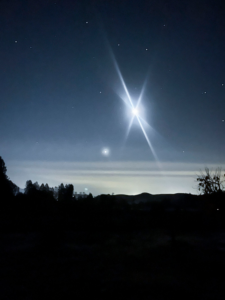Urphänomen is an online spiritual scientific research guild and reading group led by Matthew D. Segall and Ashton K. Arnoldy of the California Institute of Integral Studies. Last fall, the group studied Rudolf Steiner’s Interdisciplinary Astronomy lecture series. Here they reflect on the value of group study and on the perspective gleaned from the course that encourages each of us to participate in the experiencing of star wisdom.
Anyone paying attention to contemporary scientific cosmology will have noticed that it is undergoing something of a paradigm crisis. Anomalies that do not fit into the standard Big Bang model continue to accumulate as the new James Webb Space Telescope sends back unexpected data from the far reaches of space and time.1 While natural science has made many important advances in the last century, it may be running up against self-imposed methodological limitations. These limitations stem from the assumption that human beings are connected to the motions of the heavens only through our eyes (including their technological extensions) and abstract geometrical calculations.
Aspiring to cultivate a deeper and more concrete connection with the cosmos, we hosted an online reading group2 focused on Steiner’s “Interdisciplinary Astronomy” lecture cycle (GA 323), beginning back in August of 2023 and running every Tuesday morning (Pacific Time) until the day after Christmas. These lectures, originally delivered in January 1921, are multifaceted, going far beyond just the history and theory of astronomy into epistemology, non-Euclidean geometries, physics, embryology, morphology, and the cultivation of spiritual organs of perception. Steiner calls for and exemplifies an approach to natural science that not only allows for but presupposes an ongoing practice of spiritual formation. In doing so, he invites the late modern mind back into relationship with nature in a way that allows us to experience our own consciousness, not as an alien anomaly unfit for this world but as an expression of cosmic forces awaiting further cultivation. Feeling these forces and resonating with the world-rhythms within ourselves is learning to do consciously what was once done for us while we developed in the womb. The whole chorus of whirling worlds conspires to fold our souls into time and bodies into space. Not just our human parents’ blood and brooding but the Sun, Moon, and sibling spheres above give shape to our limbs, chest, and face.
Not only does Steiner call for a new, imaginative method of observing the heavens, but also for an entirely new set of metaphysical categories that would—for example—shed light on the intertwining of disciplines as seemingly remote as astronomy and embryology. We can no longer rest content with abstract models and logical deduction. Although new details always remain to be discovered, we cannot continue to postpone our judgment on creation’s origins as if a slightly more powerful telescope or particle collider might finally unveil the truth. Rather, as Steiner recommends, we must penetrate the phenomena intuitively, with our own bodily life and healthy senses rooted in the turning earth and our imaginations entrained with the movements of the night sky.

Accordingly, Steiner’s main refrain throughout his astronomy lectures is the need to reintegrate the human gestalt with the organism of the solar system. After touring an array of figures, calculations, and geometrical exercises, he tells his audience that his central aim throughout was to call forth within us an experience of the harmony between the human organization and the dynamics of the cosmos.3 The Ptolemaic model of the solar system, he says, functioned as a great school for the human intellect, releasing us from our primordial, atavistic participation in cosmic wisdom so as to freely reunite with it once again through our own thinking activity. The Copernican model strives for this renewed contact with cosmic wisdom but remains wed to a fixed Euclidean geometry that is ill-equipped to grasp the true motions of the heavens. These motions, in their living reality, cannot be completely captured using any model of calculation, whether geo- or helio-centric. Steiner agrees with Copernicus that the earth moves but insists that its path is no simple circle nor ellipse. These are, at best, lower-dimensional projections of its true movement, which Steiner schematically traces (figure below), such that the earth can be said to follow the sun in a twisting, screw-like lemniscatory path.
In the wake of the great disembedding achieved by materialistic modes of thought, Steiner sought to reintegrate human knowing into the cosmic process. His recommendation that we consider the metabolic rhythm between our hours spent oriented vertically while awake and horizontally while sleeping, which we ought to consider as an absolute criterion against which to define the relative movements modeled by astronomy, is a striking example. Not only our bodies but also our shifting states of consciousness are to become the means by which we gain an accurate perception of the true dynamics of the solar system—a far cry from the view of measuring extended bodies simply located in empty space. Indeed, Steiner’s indications suggest that only through cultivating the deeper modes of perception that allow for such revelations will we begin to appreciate the significance of mass-energy equivalence and quantum non-locality discovered by physicists over the last century.
As elsewhere, Steiner draws a connection between our epoch and the Egypto-Chaldean (est. 2900 BC and 747 BC), suggesting that the star wisdom instinctively cultivated then must be achieved today in waking consciousness by extending modern science through spiritual development. As with other disciplines reimagined by Steiner, astronomy is held up as something that, in the future, could belong to everyone—not just specialists. Geometrical exercises, such as drawing Cassini curves, are merely the means by which we might eventually come to inwardly participate in the music of the spheres once more. Achieving this would entail the reunion of astronomy and astrology—the outer physical and inner ethical halves of a once whole but now sundered image: a living, wakeful, imaginative perception of the world’s meaning. One of the most tantalizing indications Steiner gives is that the discipline arising from this reunion could serve a new social science and, with it, a new cosmopolitical religiosity: the potential to harmonize the social organism with the organism of the heavens in a way that preserves individual freedom while also affording new means of public participation in rituals of re-enchantment attuned to the sky.

The Value of Collaborative Study
Our group’s reading of Steiner’s “Interdisciplinary Astronomy” was the third in a series of such study sessions–part of an emerging international spiritual research network. We’ve decided to name this network Urphänomen—that stirring expression Goethe coined to designate the archetypal dynamic that reveals itself through various manifestations of metamorphosis (e.g., in meteorology, color, plant growth, animal development, etc.). The name conveys our intention to hold each reading cycle in the spirit of a more encompassing, intercultural and transdisciplinary vision. Such an approach is, of course, at the heart of anthroposophy. But, importantly, this is not a vision we consider complete or univocal, for another key intention of ours is that the group be facilitated in ways appropriate to any successful educational endeavor: an embrace of pluralism, critical dialogue, and interpretive charity. Accordingly, everyone—from seasoned anthroposophists to hardline materialists—is invited to participate in our ongoing meetings.
We launched our first reading cycle4 in the fall of 2022 with Steiner’s The Riddles of Philosophy (GA 18). By the time we took on The Philosophy of Freedom (GA 4) for the second cycle,5 something of a fellowship had forged between earnest participants. Our format consists of 1-hour video conference meetings, the first 15 minutes of which feature a summary given by one of us or by volunteers from the group. The remainder of the time is dedicated to open dialogue. Time and again, we have remarked upon the deep value that arises when diverse perspectives and backgrounds come together to contemplate one text. Though meeting virtually has its limitations, the international collaboration afforded by this format has been enriching. Following the suggestion of one participant, we eventually began live-streaming our meetings over YouTube in hopes of broadening the conversation further. As genuine community took shape, fed by regular and sincere participation, we began to host “Pop-Up” presentations offered by community volunteers or one-off conversations about contentious topics, including the question of race in Steiner’s oeuvre.6 These Pop-Ups are continuing into 2024, as will a fourth reading cycle focused on Steiner’s Occult Science: An Outline (GA 13).
The aim of Urphänomen is to engage in heartfelt study of Steiner’s key works and to bring into practice his methods so as to cultivate a new form of participation in a re-enspirited cosmos. We hope you will join us in this fellowship or start your own groups, which cannot succeed outside the context of a plurality of diverse perspectives engaged in dialogue.
Anyone interested in joining our collaborative research efforts is welcome to email us at urphanomen@outlook.com
More at Urphänomen
Title image Sunrise in Sebastopol, California. Photo: Ashton Arnoldy
Footnotes
- Adam Frank and Marcelo Gleiser (2023, September 2). “The Story of Our Universe May Be Starting to Unravel.” The New York Times.
- Youtube: Interdisciplinary Astronomy.
- Rudolf Steiner, Interdisciplinary Astronomy: Third Scientific Course, CW 323, Lecture XVII. (SteinerBooks 2020.)
- Playlist for The Riddles of Philosophy reading group.
- Playlist for The Philosophy of Freedom reading group.
- “Steiner and Racism,” a recording of our discussion.













